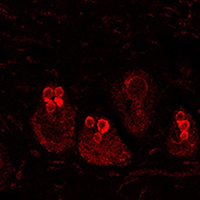A spectrofluorometric analysis to evaluate transcutaneous biodistribution of fluorescent nanoparticulate gel formulations

Submitted: 2 September 2021
Accepted: 17 January 2022
Published: 7 February 2022
Accepted: 17 January 2022
Abstract Views: 1023
PDF: 468
HTML: 17
HTML: 17
Publisher's note
All claims expressed in this article are solely those of the authors and do not necessarily represent those of their affiliated organizations, or those of the publisher, the editors and the reviewers. Any product that may be evaluated in this article or claim that may be made by its manufacturer is not guaranteed or endorsed by the publisher.
All claims expressed in this article are solely those of the authors and do not necessarily represent those of their affiliated organizations, or those of the publisher, the editors and the reviewers. Any product that may be evaluated in this article or claim that may be made by its manufacturer is not guaranteed or endorsed by the publisher.
Similar Articles
- W. Chen, J. Liang, L. Huang, J. Cai, Y. Lei, J. Lai, L. Liang, K. Zhang, Characterizing the activation of the Wnt signaling pathway in hilar cholangiocarcinoma using a tissue microarray approach , European Journal of Histochemistry: Vol. 60 No. 1 (2016)
- M. Aita, F. Benedetti, E. Carafelli, E. Caccia, N. Romano, Effects of hypophyseal or thymic allograft on thymus development in partially decerebrate chicken embryos: expression of PCNA and CD3 markers , European Journal of Histochemistry: Vol. 54 No. 3 (2010)
- M. Úbeda-Manzanaro, J.B. Ortiz-Delgado, C. Sarasquete, The Bromodomain testis-specific gene (Brdt) characterization and expression in gilthead seabream, Sparus aurata, and European seabass, Dicentrarchus labrax , European Journal of Histochemistry: Vol. 60 No. 2 (2016)
- Hui Xu, Yanbo Chen, Qi Chen, Huan Xu, Yanxia Wang, Jiao Yu, Juan Zhou, Zhong Wang, Bing Xu, DNMT1 regulates IL-6- and TGF-β1-induced epithelial mesenchymal transition in prostate epithelial cells , European Journal of Histochemistry: Vol. 61 No. 2 (2017)
- L. Fassina, G. Magenes, A. Inzaghi, S. Palumbo, G. Allavena, C. Miracco, L. Pirtoli, M. Biggiogera, S. Comincini, AUTOCOUNTER, an ImageJ JavaScript to analyze LC3B-GFP expression dynamics in autophagy-induced astrocytoma cells , European Journal of Histochemistry: Vol. 56 No. 4 (2012)
- Francesca Diomede, Maria Zingariello, Marcos F.X.B. Cavalcanti, Ilaria Merciaro, Jacopo Pizzicannella, Natalia de Isla, Sergio Caputi, Patrizia Ballerini, Oriana Trubiani, MyD88/ERK/NFkB pathways and pro-inflammatory cytokines release in periodontal ligament stem cells stimulated by Porphyromonas gingivalis , European Journal of Histochemistry: Vol. 61 No. 2 (2017)
- E. Wyroba, P. Kwaśniak, K. Miller, K. Kobyłecki, M. Osińska, Site-directed mutagenesis, in vivo electroporation and mass spectrometry in search for determinants of the subcellular targeting of Rab7b paralogue in the model eukaryote Paramecium octaurelia , European Journal of Histochemistry: Vol. 60 No. 2 (2016)
- Liying Shen, Kongjie Lu, Zhenfeng Chen, Yingwei Zhu, Cong Zhang, Li Zhang, Pre-treatment with galectin-1 attenuates lipopolysaccharide-induced myocarditis by regulating the Nrf2 pathway , European Journal of Histochemistry: Vol. 67 No. 4 (2023)
- Ermanna Turano, Federica Virla, Ilaria Scambi, Sylwia Dabrowska, Oluwamolakun Bankole, Raffaella Mariotti, Adipose mesenchymal stem cells-derived extracellular vesicles exert their preferential action in damaged central sites of SOD1 mice rather than peripherally , European Journal of Histochemistry: Vol. 68 No. 3 (2024)
- Renata Tabola, Magdalena Zaremba-Czogalla, Dagmara Baczynska, Roberto Cirocchi, Kamila Stach, Krzysztof Grabowski, Katarzyna Augoff, Fibroblast activating protein-α expression in squamous cell carcinoma of the esophagus in primary and irradiated tumors: the use of archival FFPE material for molecular techniques , European Journal of Histochemistry: Vol. 61 No. 2 (2017)
<< < 3 4 5 6 7 8 9 10 11 12 > >>
You may also start an advanced similarity search for this article.

 https://doi.org/10.4081/ejh.2022.3321
https://doi.org/10.4081/ejh.2022.3321











